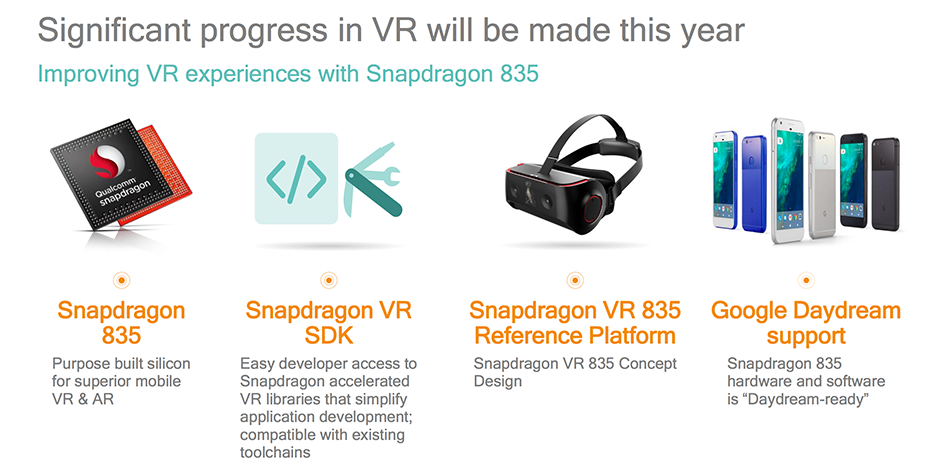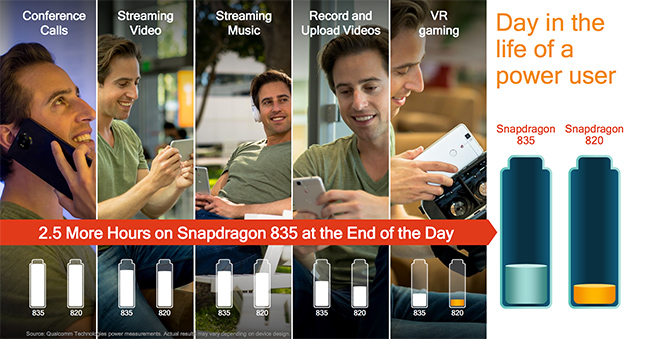The Qualcomm Snapdragon 835 Performance Preview
by Matt Humrick & Ryan Smith on March 22, 2017 4:30 AM EST- Posted in
- Smartphones
- Snapdragon
- Qualcomm
- Mobile
- SoCs
- Snapdragon 835
- Kryo
First Thoughts
Mobile SoCs are packed with specialized processors: CPU, GPU, high-performance DSP (compute), low-power DSP (sensor hub), modem DSP (signal processing), ISP (image processing), fixed-function blocks (video, audio), etc. And while all of these pieces contribute to the overall user experience, some of them are difficult to quantify. The CPU and GPU remain vital to device performance and battery life, so it’s still important to probe their capabilities.
Our initial testing shows that Snapdragon 835’s Kryo 280 CPU is an octa-core, big.LITTLE configuration with four semi-custom A73 “performance” cores and four semi-custom A53 “efficiency” cores. Kryo 280’s performance cores are pretty much equivalent to Kirin 960’s A73 cores in both integer and floating-point IPC, but comparing them to Snapdragon 820’s Kryo CPU shows mixed results: integer IPC improves but floating-point regresses.
In our limited system testing, the Snapdragon 835’s IPC gains outweigh its losses, providing better overall performance than the Snapdragon 820/821 phones. Unsurprisingly, the Snapdragon 835 MDP/S matched the performance of the Mate 9’s Kirin 960, which may not sound all that exciting, but considering our positive experience with the Mate 9, it’s certainly not bad either.
Qualcomm continues to push hard into VR/AR, not just with smartphones but stand-alone HMDs too. The high resolution and low latency requirements for these experiences suddenly make the GPU a bottleneck once again. The Snapdragon 835’s updated Adreno 540 GPU, through a combination of microarchitecture tweaks and a higher peak operating frequency, is another evolutionary step along the VR path, delivering a 25% peak performance boost over Snapdragon 820’s Adreno 530.
As noted earlier, all of these results came from pre-production hardware and software that’s under Qualcomm’s control, so performance could still go up or down once retail units begin shipping; however, based on these preliminary numbers and feature additions, the Snapdragon 835 looks like a solid evolutionary upgrade over the S820. The one glaring omission in this initial assessment, though, is power efficiency, which is critical to both battery life and sustained performance. The potential power savings from the move to 10nm and the CPU swap could have a larger impact on user experience than the small performance gains and new features.













128 Comments
View All Comments
gigathlete - Wednesday, March 22, 2017 - link
There is individual load times per app at the end of the video did you finish the whole thing?techconc - Monday, April 3, 2017 - link
@TadzioPazurThe "test" isn't broken. Rather, it's a measure of NAND storage performance rather than of the SoC.
grayson_carr - Saturday, March 25, 2017 - link
Kind of an unfair test. On Android, they completely disabled animations, so apps appear as soon as they are loaded, but on iOS there is no option for that. They claim they disabled animations on iOS, but they actually just enabled the reduce motion feature, which doesn't disable animations, but just changes them from a zoom to a fade animation.TadzioPazur - Wednesday, March 22, 2017 - link
No. You seem to miss the point, as apperent from your post, comparing a SoC (835) to a complete product (6 month old phone). This is an important distinction, as pointed out by the editors: commanding victories in JS department come largely (if not solely) from the JS engine used by the browser.Let's nitpick the iPhone7s standings:
CPU tests: 8 x N/A, 3 x 1st (all JavaScript)
GPU tests: joint 1st, 2nd, N/A, N/A, 6, 2, 12, 1, N/A N/A, joint 1st
So iPhone is present on 10 graphs, being non-joint 1st ("trouncing everything else") on 4 of them. Hardly "most of graphs".
lefty2 - Wednesday, March 22, 2017 - link
iPhone 7 scores 3306 in geekbench 4 single core, while the fastest android Samsung Galaxy S7 scores 1789 (https://browser.primatelabs.com/ios-benchmarks). So, yankeeDDL is correct, Apple's A10 trounces everything else (in single thread, which is the most important in a smartphone).joms_us - Wednesday, March 22, 2017 - link
Except that Geekbench is worthless and does not represent real-world performance.melgross - Wednesday, March 22, 2017 - link
No worse than any of the other tests such as PCMark. The importance is that all of these devices will perform about the same in real world use as they do in these tests.milli - Wednesday, March 22, 2017 - link
Geekbench is synthetic. PCMark tests with actual apps.joms_us - Thursday, March 23, 2017 - link
Yep, PCMark is the best out there. It is doing real tasks, you can see what it is doing not just some random progress bar or percent like Geekbench LoL.arayoflight - Wednesday, March 22, 2017 - link
Geekbench scores shouldn't be compared across platforms since language used as well as the compiler can make a lot of difference.My old lenovo y510p scored 3600 single core on geekbench single core in Windows. When I booted in Ubuntu, the score jumped to 4400. Multi core scores were 11000 and 12500 respectively.
As evident, it's pretty pointless to compare it. Not to mention that almost all the tests can be done in L2 cache if it's sufficiently big. That's a really unrealistic test.